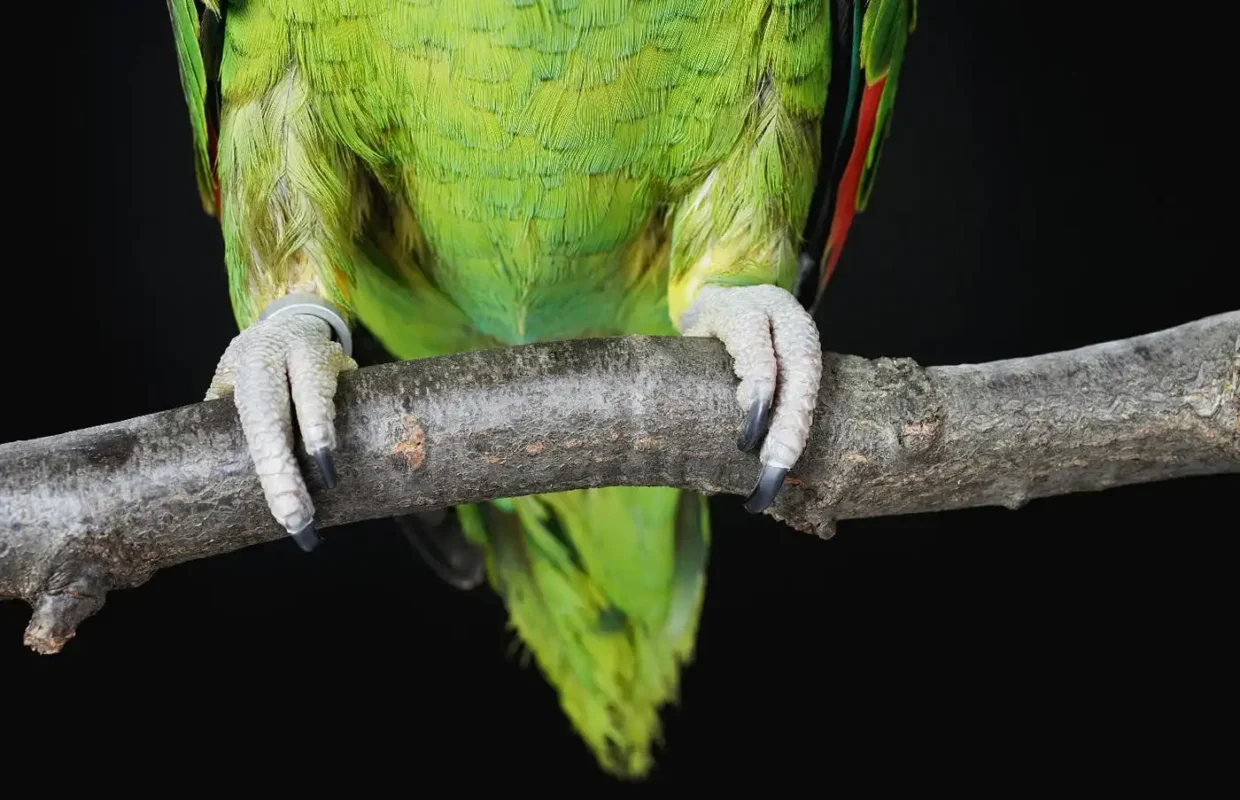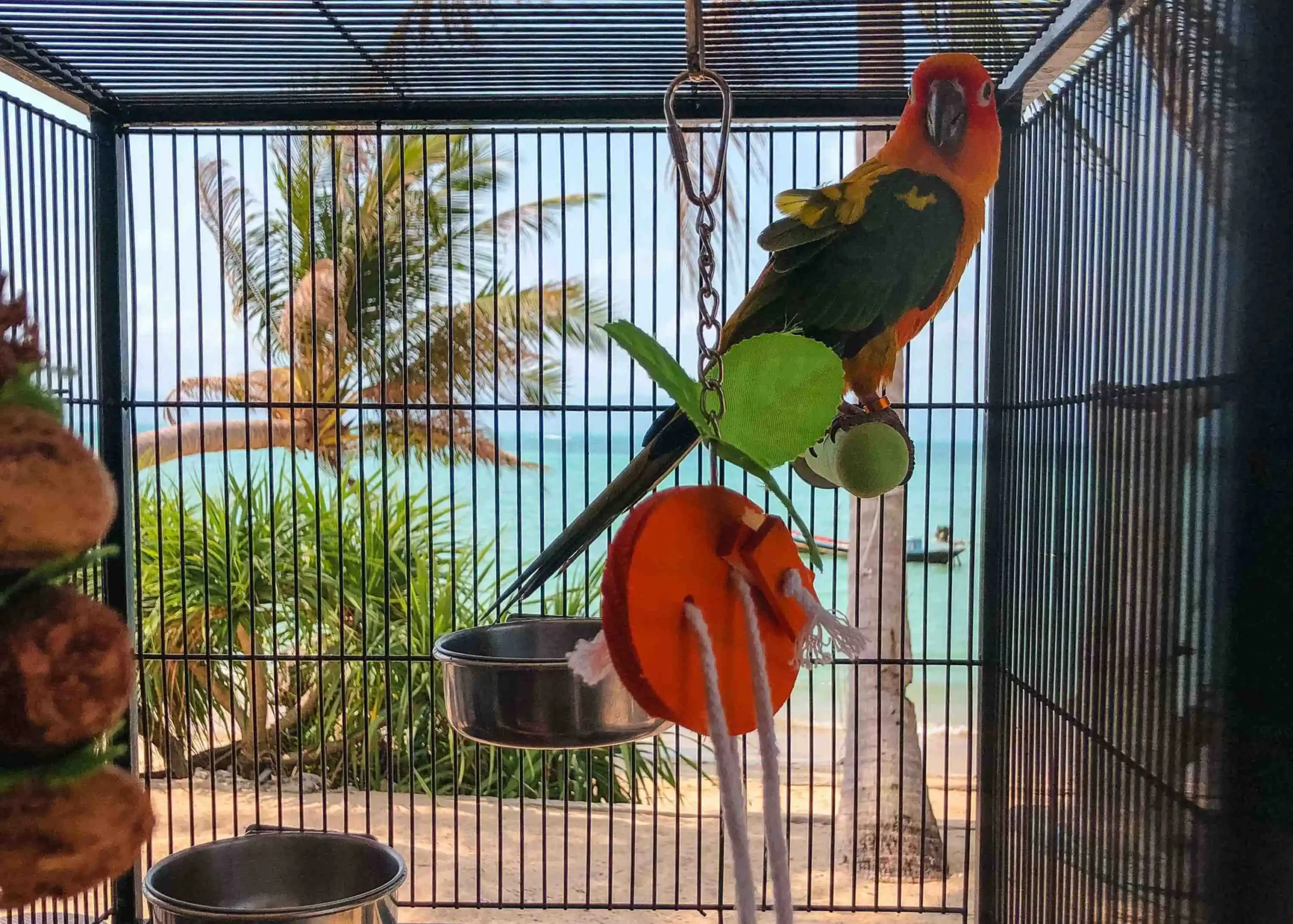Health & Care, Blogs
Parrots Feet on a Perch: Comfort and Health Tips
Have you ever watched your parrot hold onto its perch? Its tiny toes curl around the wood with perfect precision. This action is more than just a simple grip; it’s a sign of their comfort and health. Your parrot’s feet are key to their well-being and show how they feel.
Understanding how their feet fit with their perches can tell you a lot about their health. If perches are not right, it can cause serious foot problems. So, it’s important to know how to take care of your parrot.
By paying attention to your bird’s behavior, you can make their living space better. This helps improve their life quality.
Parrots stand on their feet all day, every day, making foot health very important. Their feet should wrap around the perch about 3/4 of the way to grip and balance. Using perches of different sizes helps prevent foot issues like arthritis and keeps their feet strong.
Knowing how birds perch and the structure of their feet helps you choose the right perches. This makes a big difference in their health.
Key Takeaways
- Proper perching is vital for your parrot’s foot health and overall comfort.
- Varying perch diameters can help prevent foot problems.
- Understanding perching behavior enhances your parrot care strategies.
- Regular foot care is necessary to avoid serious health issues.
- Choosing the right materials for perches can significantly impact their well-being.
The Importance of Parrots Feet on a Perch
Understanding how your parrot’s feet fit on a perch is key to their health and happiness. Parrots have special feet that help them perch and balance. Their feet have two toes pointing forward and two backward, making them grip and balance well. This special design lets them move around easily.
Understanding Bird Perching Behavior
Birds stand on their feet all day, so keeping their feet healthy is important. About 75% of a bird’s feet should wrap around a perch for good grip and balance. Different perch sizes can prevent foot problems like arthritis. So, setting up the right perch is key for your parrot’s well-being.
Functional Anatomy of Parrot Foot Structure
Parrots’ feet have special features to prevent foot problems. Using natural branches for perches helps keep their feet healthy. It’s also important to check their nails often, as long nails can make perching hard
| Perch Type | Benefits | Drawbacks |
|---|---|---|
| Natural Wood | Mimics the natural environment | Potentially hazardous if untreated |
| Sandy | Helps maintain nail length; stimulates blood flow | Can be abrasive if overused |
| Rope | Comfortable; allows for foot stretching | Risk of fraying and ingestion |
| Wooden Dowel | Basic option | Lacks variety and exercise stimulation |
By considering these points, you can make your parrot more comfortable and healthy. Choose perches that fit their special feet and perching habits.
Choosing the Right Perches for Your Parrot
Choosing the right perches is key for your parrot’s foot health and happiness. It’s important to pick perches of different sizes. This helps keep their parrot claw strength up and prevents foot injuries. Different perches also help them act naturally, which is good for their perching birds adaptation.
Variety in Diameter for Optimal Grip
It’s smart to have perches of different sizes for your parrots. This keeps their feet strong and healthy. A good perch should let a bird’s feet wrap around it a bit, helping with balance and grip. This is key to avoiding foot problems and keeping their feet flexibles.
Material Selection: Natural Wood vs. Synthetic Perches
What a perch is made of matters a lot for your parrot’s comfort and safety. Natural wood is a top choice because it’s smooth for parrots to chew on and feels like their natural home. Perches made from Manzanita, Dragonwood, and Java Wood are great because they’re strong and come in different sizes6.
Sandy perches can help trim nails and improve blood flow but aren’t good for long periods. Rope perches, on the other hand, are great for keeping your parrot’s feet active. But, be careful because worn-out rope can hurt their toes and feet.
Types of Perches to Avoid
Stay away from perches that are too uniform, like dowel or cement ones. They don’t change size much and can hurt your parrot’s feet. Go for natural branch perches instead. They come in different shapes and sizes, making them more comfortable and better for your parrot.
| Perch Type | Benefits | Drawbacks |
|---|---|---|
| Natural Wood | Variable diameters, durable, chewing surface | Requires frequent cleaning |
| Sandy Perches | Nail trimming assistance | Not suitable for long-term use |
| Rope Perches | Encourages movement and foot engagement | Risk of trapping toes if frayed |
| Dowel Perches | Standard option, widely available | Lack of grip variety, can lead to injuries |
Maintaining Foot Health for Comfort
To keep your parrot happy and active, it’s key to focus on their foot health. A good diet is crucial for strong feet. Foods full of nutrients help their overall health and keep their feet in top shape.
The Role of Proper Nutrition
Feeding your parrot a mix of fruits, veggies, and quality pellets is essential. They need calcium and vitamin D for strong bones and joints. These nutrients help avoid foot problems, keeping your parrot healthy.
Routine Nail Care and Maintenance
Trimming your parrot’s nails regularly is a must to prevent overgrowth. Long nails can hurt your parrot and lead to foot sores. Using different types of perches helps keep their feet healthy by preventing bumblefoot. Clean perches with soap and hot water every week to keep things clean.
Recognizing Signs of Foot Problems
Watch out for foot sores in your parrot to stop them from getting worse. Issues like bumblefoot, infections, gout, arthritis, and fractures can happen. Look for any signs of pain or odd behavior. For cuts, clean them gently with a mild antiseptic or saline. Coconut oil can moisturize their feet safely. Feathersoft Spray can also help keep their feet healthy by keeping moisture in. If things get serious, see a vet quickly to get the right care.
| Foot Health Issue | Symptoms | Treatment Options |
|---|---|---|
| Bumblefoot | Sores, swelling | Veterinary care, antiseptic treatment |
| Foot Infections | Redness, discharge | Antibiotics, proper hygiene |
| Arthritis | Limping, difficulty perching | Anti-inflammatory medication, vet advice |
| Fractures | Unusual positioning, pain | Immediate veterinary assessment |
Keep an eye on your parrot’s foot health and deal with problems fast. This way, you can make sure they live a happy, active life.
Tips for Creating a Bird-Friendly Environment
Creating a bird-friendly space boosts your parrot’s health and happiness. It’s all about the right perch placement and keeping things clean and fun. This ensures your parrot has a great place to live.
Monitoring Perch Placement
Putting perches in the right spots is key for your parrot’s comfort. About 75% of a bird’s feet should fit on a perch for good grip and balance. Using different sized perches helps prevent foot problems like arthritis.
Ensuring Perches Are Clean and Safe
Keeping perches clean is crucial for your bird’s health. Sterilize perches before adding them to the cage to stop bacteria from spreading. Clean perches regularly to keep your parrot’s home safe and clean.
Change the water in bird baths often to stop algae and bacteria from growing. Clean perches make your bird’s space look better and stay healthy.
Providing Exercise and Enrichment
It’s important to keep your parrot busy with fun activities. Toys and climbing structures help with exercise and keep their minds sharp. Adding perches or rocks to bird baths helps smaller birds feel safe while drinking.
Learn about the habits of local birds to make a better home for them. Keeping your parrot active stops boredom and keeps their feet healthy.
Conclusion
Throughout this article, we’ve seen how important perches are for parrots. Choosing the right materials like Apple and Birch wood helps keep their feet healthy and comfortable. Keeping perches clean and replacing them when needed is also key for foot health.
It’s also crucial to watch how your parrot acts, like when they regurgitate or move their head. This helps you understand what they need. By combining these tips, you can make a safe and healthy space for your parrot. This way, your parrot’s feet stay strong and secure, leading to a happy life together.
In conclusion, focusing on these key points will greatly improve your parrot’s health. Making a few changes in their living space and habits can make a big difference. It shows how important good foot care is for your parrot’s happiness and health. A happy bird means a happy owner!


